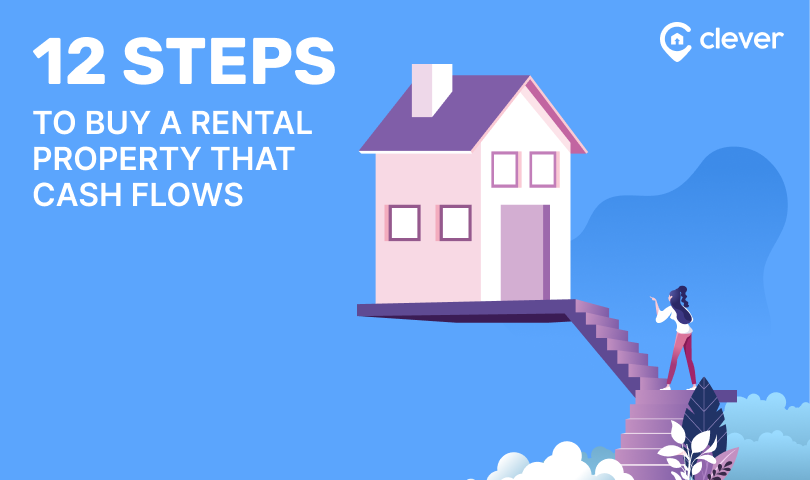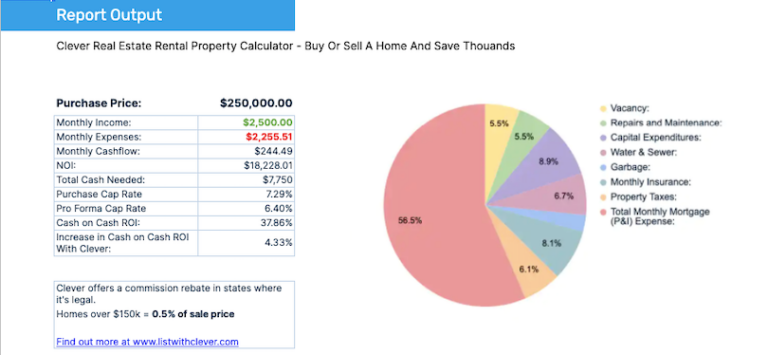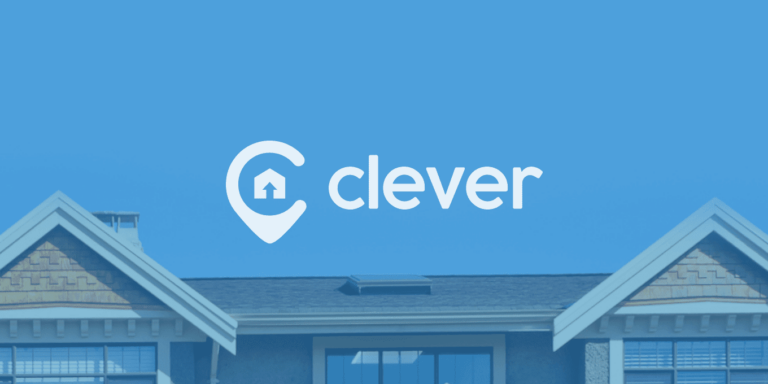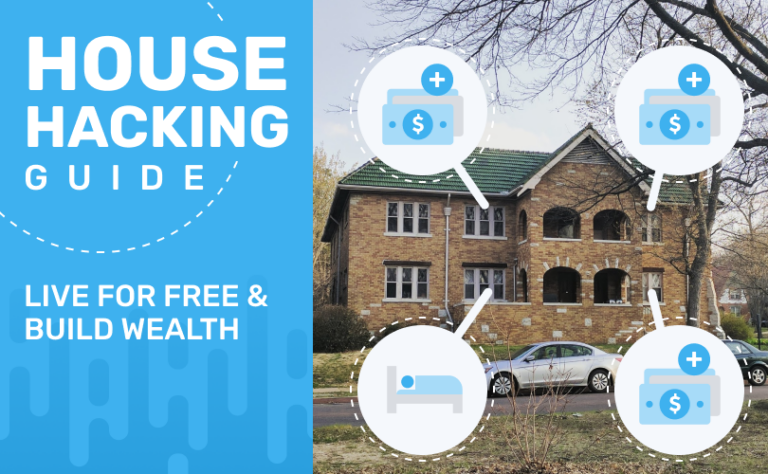There are 12 steps you need to take to buy a great rental property that cash flows. This guide will teach you all 12 so you’re ready to purchase an investment property.

Building a portfolio of investment property was easily the best financial decision I’ve ever made. It's allowed me to create a snowball effect of cash flow from my rental properties that lets me buy additional properties and keep my monthly cash flow growing.
However, before I got to a portfolio of 22 doors, I had to take the plunge and buy my first property.
I remember how nervous I was about spending such a large portion of my net worth on one thing. I was worried whether I was actually buying a good deal — and if I’d be able to maintain the property to keep it rented.
It ended up working out for me, but I had to learn a lot of lessons the hard way. If I knew then what I know now, I would’ve saved thousands of dollars — and hours and hours of pain.
If you’re considering purchasing your first rental property, this guide will make it a whole lot easier (and less painful) than it was for me!
JUMP TO SECTION
- Video - How To Buy A Rental Property
- Step 1: Set Your Goals
- Step 2: Set Your Budget
- How To buy a rental property with no Money Down
- Step 3: Learn how to forecast cash flow
- Step 4: Choose a market
- Step 5: Get Pre Approved For Financing
- Step 6: Start looking for properties
- Step 7: Start making Offers
- Step 8 : Inspections
- Step 9 (optional): Choose a property management company
- Step 10: Locking in your financing
- Step 11: Closing day!
- Step 12: Growing your portfolio
Video - How To Buy A Rental Property
In this video, I’ll walk you through the 12 steps covered in this guide — and share some details on my own portfolio.
Step 1: Set Your Goals
This step is often overlooked, but it’s incredibly important. After all, it’s very hard to build a successful portfolio if you don’t know what success actually looks like.
Ask yourself, "Why do I want to own an investment property?" You might have answers like "I want to quit my 9-5 job" or "I want to be able to travel the world" or "I want $20,000 in extra income per year."
The answer to the question makes it easier to pick your long-term strategy. If you want to replace your job so you can travel, you might decide that your goal is to create $10,000 a month in cash flow to comfortably replace your job.
If you decide to invest in multi-family apartments, that might mean accruing 40 doors that generate $250 per month in cash flow. You could build a portfolio as small as 10 4plexes (apartments).
Or you could buy houses that generate $600 per month, which would 17 single-family homes that you rent out.
Whatever your goal is, it’s important to have one, so you can pick a strategy that is able to get you there in a time that’s acceptable for you.
Personally, my partner and I have a goal of reaching financial freedom by generating $20,000 a month in passive income. We are going to achieve this goal by building a large portfolio of apartments in St. Louis City and County. We are on pace to have 80 apartments by the end of 2021, and should reach our goal in 2022.
Step 2: Set Your Budget
Before you swing into action, you need to understand what you can afford in an investment property.
Setting a budget is actually simpler than most people expect, as there are only two things you need to consider when it comes to the down payment.
First, ask yourself how much cash you’re actually comfortable investing. Some people are comfortable putting upwards of 50% of their wealth in property, while others never want real estate to be more than 20-25% of their total wealth.
Pick a number that works for you, then multiply it by five to get the total amount of property you can afford (the bank will cover 80%)
The second question you need to ask yourself is whether you’re willing to house hack.
House Hacking is when you purchase a multi-family property, then live in one unit while renting out the others.
By living in the property, you qualify for a loan that’s as low as 3.5% down, which enables new investors — who might not otherwise be able to afford a property — to buy large rentals.
House hacking was how I got started — if you’re willing to live in a duplex, triplex, or 4plex, I can’t recommend it enough.
How To Buy A Rental Property With No Money Down
If you’re reading this, don’t have a ton of capital to invest, and aren’t interested in house hacking, there’s still a way for you to get started in real estate!
While it can be difficult to accomplish, there are deals out there you can get into for no money down.
What you’re looking for are sellers that are willing to do owner financing and give you a mortgage instead of the bank.
In my experience, owner financing is often more popular with older sellers who own their property free and clear. By being the bank and financing the property, they get to collect the interest from the loan in addition to the sale price.
This can be a great deal for the seller if they’re using the monthly payments to retire on — as opposed to taking the proceeds from the sale in one lump sum to purchase more investment properties.
Step 3: Learn how to forecast cast flow
If you’re buying an investment property, it’s probably for the monthly income. However, not all properties listed for sale will actually cash flow, — many will have more monthly expenses than income.
Before you can buy a property, you MUST be able to model the financials so you can determine whether it’s A) a good deal and B) will help you meet your goals.
To model your properties, I recommend using this free rental property calculator I built. The accompanying article and video tutorial walks you through exactly how to estimate expenses and potential income of a property.
Once you’ve mastered the calculator, you’re ready to choose a market and start modelling properties to find deals that will help you hit your financial goals.
Advanced Rental Property Calculator (free)Step 4: Choose a market
Now that you’ve set your budget and you know how to model investment properties, it’s time to choose a market.
I’d recommend that you start with your own market and see if it can meet your goals. It's much easier to invest in your backyard than somewhere else.
Start by modeling a few different types of properties (single-family, duplex, 4plex) in nearby neighborhoods with the rental property calculator and see what’s coming out cash flow positive.
If you find deals providing a minimum of 5% cash-on-cash return, there’s a good chance you can make things work in your own market.
If not, I’d recommend asking some local investors what markets they’re investing in — namely because if you do end up investing out of state, you’re going to need referrals for great real estate agents, managers, and contractors.
You can also use Clever to find a great buyer’s agent in any market you choose, who can make these introductions for you.
Buy a Rental Property and Get a Rebate
Get up to 1% of your investment back when you buy with Clever
Step 5: Get Pre Approved For Financing
Now that you’ve picked a market, the last thing you need to do before you start looking at properties is to get pre-approved for financing.
I recommend asking your real estate agent for a lender that they trust, as a good lender can save a deal from unexpected financing problems that an inexperienced lender wouldn’t be able to handle.
Your lender will ask for some basic financial information then issue a pre-approval for the maximum amount that that you can purchase.
Getting pre-approved won’t impact your credit, but it will make sellers take your offer seriously, because it shows them you’re actually able to purchase their home. In competitive markets, sellers often won’t accept your offer if you’re not pre-approved.
Step 6: Start looking for properties
The time has finally come: You’re ready to seriously look for properties!
The two main ways to find investment properties are on market and off market.
Finding properties on market
Properties that are on the market are listed on the MLS by real estate agents, and they get syndicated to popular websites like Zillow, Realtor.com, and Trulia.
Investment properties can be competitive, so I’d recommend asking your realtor to set you up with "MLS Alerts."
This means you get an email the moment a home that meets your criteria hits the market, so you can quickly evaluate it and decide if you want to make an offer.
Finding properties off market
Off-market properties are investments that aren’t listed for sale on the MLS. You’ll need to hunt these down yourself — or be connected to other investors.
If you’re interested in off-market property, I’d recommend you start by looking for properties in your market that have for-rent signs in the yard, but aren’t on any online rental sites — or only on Craigslist.
These landlords haven’t kept up with new technology, and there’s a good chance their properties are rented below market and they might be interested in selling.
I found the second property I ever purchased using exactly this method.
Here are a few other ways to find off-market properties:
- Going to real estate investor meetings and buying from other investors
- Buying from wholesalers that have property under contract
- Sending direct mail to rundown property you’re interested in
- Cold calling owners of property you’re interested in
- Putting up bandit signs that let people know you are looking to buy (note: this is not legal everywhere)
Step 7: Start making Offers
Once you’ve found a property that meets all of your goals and seems like a good investment, it's time to make an offer!
Here are some tips and tricks that can help get your offer accepted for the lowest possible price:
- Don’t be afraid to offer significantly below list price. We’re looking for deals, so offer a price that meets your return, and don’t worry about losing the deal. I’d rather wait for a good deal than buy something average now.
- If your offer gets rejected but the property is still on the market two weeks later, resubmit! The seller might change their mind.
- If you can swing it, shortening the inspection period can make sellers more likely to choose your offer, as they will find out sooner if the deal is going through.
- Send a custom letter with your offer introducing yourself and your goals with the property — make sure the letter paints you in a good light, so the seller is confident you can close!
Ready to Make an Offer?
Get up to 1% of your investment back when you buy with Clever
Step 8 : Inspections
Congratulations on getting a property under contract! Now you just have to make it through inspections and financing — then you’re ready to close.
Inspections are your chance to make sure the property you're purchasing isn’t going to have any unexpected expenses.
It's also a great time to negotiate any expenses or issues you do find into repair credits or a reduction in price.
For new investors, I STRONGLY recommend that you use a licensed home inspector for your first purchase. They will give you a detailed report that’s usually 20+ pages long that outlines every aspect of your house — and if it needs any work.
I’d also STRONGLY recommend you hire a separate company to run a camera through the sewer to make sure there’s no cracks or breaks in the line.
For experienced investors, it's common to not hire a licensed inspector, but instead bring out their real estate team.
When my partner and I purchase properties, we often bring out our roofer, HVAC guy, electrician, interior contractor, property manager, and a sewer company to camera the sewers.
While we don’t end up with a 20-page report, we finish our walkthrough with detailed bids from our contractors of exactly how much it's going to cost to renovate the property — and a rental listing price from our property manager — making it easy for us to evaluate a deal.
This only works because we’ve done a lot of work with our team, and they know that if we do end up purchasing the property, they’ll be hired to do any necessary repairs.
Step 9 (optional): Choose a property management company
If you’re investing out of state — or don’t have the time to manage rental property — you will need to choose a property management company.
Ask your agent and other investors for referrals, then schedule some interviews. Here are some things you should always ask when evaluating prospective property managers:
- How they do their accounting, and ask for a sample report
- Their hourly rates for different maintenance services
- Their fee structure for management
- If you can interview some of their current clients (property owners)
Once you’ve picked a manager, you will want to loop them in on the closing date, as they will actually be the ones getting the keys on closing day.
Step 10: Locking in your financing
Once you go under contract, your lender will ask you for much more detailed financial information, and run a hard pull on your credit to verify everything.
Then they’ll conduct an appraisal of the property to make sure it's worth at least what you’re paying for it.
Be ready for a lot of back and forth — particularly when it comes to sending requested documents — but nothing should be overly difficult.
Step 11: Closing day!
Congratulations on making it to closing day!
Closing day might not be what you’re expecting, as more and more closings are taking place virtually. Regardless of how or where it happens, expect to sign a ton more paperwork than you expect.
Closings for the buyer and seller generally take place at different title companies (or virtually). If you’re using a property manager, you’ll probably never actually get a set of keys (the manager will collect them).
Take a moment to relax — finding and purchasing a great investment deal is a long hard journey, and you’ve done it!
Step 12: Growing Your Portfolio
Now that you’ve closed on your property, if you didn’t hire a property manager, it’s important that you learn how to become a great landlord. Managing your tenants and maintaining your property will make or break your investments returns.
Once you get the hang of being a landlord, it's time to take what you’ve learned and repeat the process.
In some cases, it might make sense to sell one of your properties and use the proceeds to buy a larger one that will generate more cash flow. If you do this, you can use a 1031 exchange to defer any capital gains tax.
For most investors, the next step is simply starting the process over — i.e., looking for your next property while maintaining your existing portfolio.
Whichever path you take, I’d recommend checking out our complete guide to real estate investing, as it can help you grow your portfolio even faster!
Related Articles



